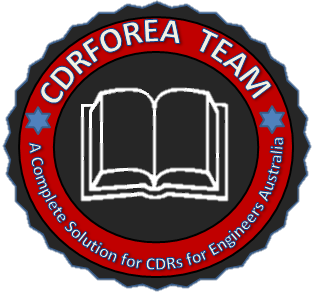If you’re an engineer who studied outside Australia and dream of working down under, the first step is the Engineers Australia Overseas Qualification Assessment (OQA). This assessment, part of the Australian Migration Skills Assessment (MSA) process, checks that your overseas engineering degree and experience match Australian standards. Passing it can unlock a skilled migration visa (such as Subclass 189, 190, or 491), help you find an engineering job in Australia, or qualify you for further study or professional membership.
In this friendly guide, we’ll walk you through everything about the Overseas Qualification Assessment: what it is, who needs it, the different evaluation pathways, required documents, step-by-step application instructions, tips for success, and common pitfalls to avoid. We’ll also point you to helpful resources like our Engineers Australia Degree Assessment guide and the official Engineers Australia Skills Assessment Guidelines. Let’s get started on turning your overseas qualification into an Australian engineering credential!
What Is the Overseas Qualification Assessment?
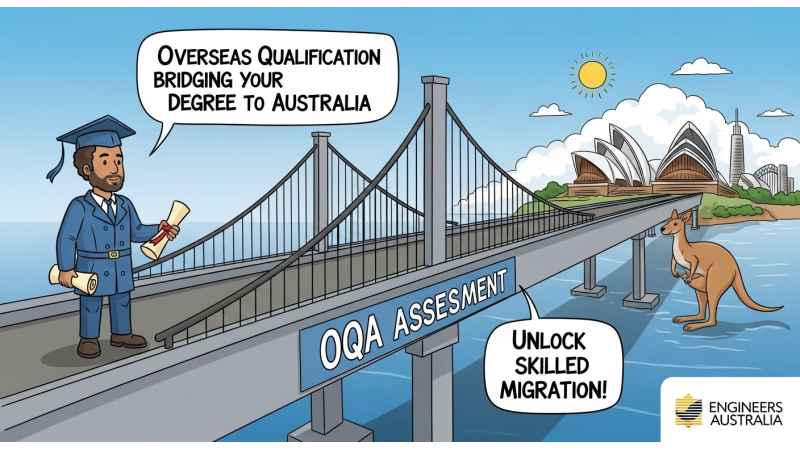
The Overseas Qualification Assessment (OQA) is the process by which Engineers Australia (EA) – the official assessing authority – evaluates the credentials of engineers who earned their qualifications outside Australia. In effect, EA compares your degree, coursework, and competencies to those of an Australian engineering graduate. If your overseas degree is determined to be equivalent to an Australian engineering qualification, you will receive a positive skills assessment outcome.
EA has been authorized by the Australian government to ensure that migrant engineers meet the required standards. This means before you can apply for a skilled visa or certain jobs, you must obtain an EA skills assessment letter. The process covers not only your university degree but also your work experience (via the CDR pathway) and English language ability. By following the official Engineers Australia Skills Assessment Guidelines, you ensure that you submit all required documents and follow the ethical standards EA expects. In short, the OQA proves to employers and the Department of Home Affairs that your qualifications and skills are on par with those of Australian engineers.
Who Needs the Overseas Qualification Assessment?
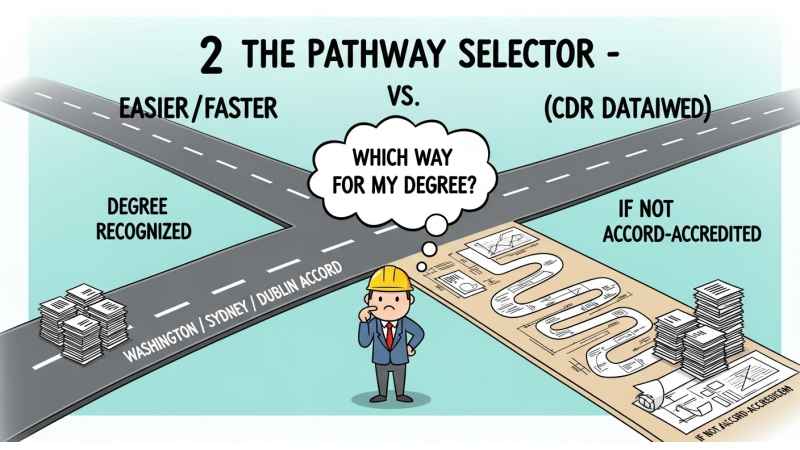
If you want to work as an engineer in Australia on a skilled migration visa, and your engineering degree is from a country outside Australia, then you need an OQA from Engineers Australia. In practice, you need to apply if your qualification is not automatically recognized under the international Accords and you are not already a registered Australian engineer. Common situations include:
-
Overseas degree: You earned your engineering degree in a country other than Australia.
-
Non-Accord qualifications: Your degree is not recognized by the Washington Accord (for 4-year degrees), the Sydney Accord (for 3-year engineering technologist diplomas), or the Dublin Accord (for 2-year engineering associate degrees).
-
CDR route: You intend to apply under the Competency Demonstration Report (CDR) pathway because your qualification isn’t accredited by the Accords.
-
Purpose of recognition: You need official recognition of your qualifications in order to apply for a visa, seek employment, or join a professional register in Australia.
In short, any international engineering graduate who wants official Australian recognition must have EA assess their credentials. For example, engineers educated in Bangladesh, Nepal, Pakistan, Sri Lanka, many African countries, the Middle East, and other nations often need to go this route if their universities are not Washington/Sydney/Dublin signatories. Even if you have extensive work experience, EA still requires the academic evaluation first.
We also offer a related page on the Engineers Australia Degree Assessment process, which covers the same steps but from the perspective of the degree itself. In that guide you’ll find additional tips on submitting transcripts, preparing your CDR, and avoiding common errors.
Understanding the Assessment Pathways
Engineers Australia provides four main pathways for assessing engineering qualifications, depending on the country and level of your degree:
-
Australian Qualification Pathway: Use this if you studied in Australia (and your program is accredited by EA). This is usually straightforward, as an accredited Australian degree is automatically accepted.
-
Washington Accord Pathway: For engineers with a 4-year professional engineering degree from a country that is a full signatory of the Washington Accord (e.g. USA, UK, Canada, China, India, South Africa, etc.). No CDR is needed; EA will recognize your degree as meeting Stage 1 competency.
-
Sydney Accord Pathway: For those with a 3-year engineering technologist or diploma from a Sydney Accord country (e.g. Canada (technologist degrees), UK (foundation degrees), Hong Kong, etc.). Again, the degree is recognized if it was accredited under the Accord.
-
Dublin Accord Pathway: For 2-year associate engineering degrees from a Dublin Accord country.
-
Competency Demonstration Report (CDR) Pathway: This is not an “Accord”, but a pathway. Use the CDR route if your qualification is not covered by the above Accords, or if your occupation differs from your qualification title. In this case, you must prepare a detailed CDR Report to demonstrate your competencies.
Note: If your country is a signatory of the Washington, Sydney, or Dublin Accords (and your graduation year falls under the period of accreditation), you generally don’t need a CDR. Otherwise, the CDR pathway applies. For example, an engineer who studied in India (Washington Accord member) from 1998 onwards would typically qualify for the Washington Accord pathway. But an engineer from a non-Accord country (or whose program wasn’t accredited) must go the CDR route.
Each pathway has specific requirements. Under any pathway, Engineers Australia will verify that your degree level and content match the chosen ANZSCO occupation (e.g. Civil Engineer 233211, Mechanical Engineer 233512). If accredited, the process is quicker. For unaccredited degrees, the CDR requires three Career Episodes (detailed narratives of your engineering work or projects), a Summary Statement linking your experiences to EA’s competency elements, and a Continuing Professional Development (CPD) list.
The official EA Migration Skills Assessment page (and its Skills Assessment Guidelines) explain these pathways in detail. We recommend you use EA’s Qualification Checker tool as a first step – it will tell you which pathway applies to your country/degree.
Key Components of the Overseas Assessment
The OQA evaluates three main aspects of your profile: your qualifications, your English proficiency, and (if needed) your competency report.
-
Evaluation of Qualifications: EA will examine your academic documents to ensure your degree is at least the equivalent level of an Australian engineering degree. This means checking the duration of study and course content. For example, EA will confirm that the subjects you studied align with the nominated ANZSCO occupation. They also verify that you meet the minimum educational length for that occupation (usually 3-4 years of full-time study).
-
English Language Ability: You must demonstrate sufficient English proficiency by providing an approved test score. EA requires one of the following, with minimum scores in each section:
-
IELTS Academic: at least 6.0 in Listening, Reading, Writing, and Speaking.
-
TOEFL iBT: Listening 12, Reading 13, Writing 21, Speaking 18.
-
PTE Academic: at least 50 in each communicative skill.
If you cannot provide a recent test result meeting these thresholds, your application will not proceed. (These scores mirror what the Department of Home Affairs requires for migration, so plan your test ahead.)
-
-
Competency Demonstration (if applicable): Only applicants using the CDR pathway need a CDR. A complete CDR Report consists of:
-
CPD List: Details of any further training or courses you’ve taken beyond your degree (seminars, short courses, self-study).
-
Three Career Episodes: Each is a narrative account (about 1000-2000 words) of an engineering project or work episode you undertook, written in first person. You should describe the project, your personal role, the tasks you performed, and the technical challenges you solved. Be sure to include plenty of technical detail and engineering analysis in each episode.
-
Summary Statement: A matrix-style summary that explicitly maps the competency elements of EA (such as “Knowledge and Skill Base” and “Engineering Application Ability”) to specific paragraphs in your Career Episodes. It shows EA assessors exactly where you demonstrated each required competency.
EA will use your CDR to judge whether your practical experience and skills match Australian engineering expectations. If your degree is accredited under an Accord, you can skip the CDR entirely; otherwise, it is mandatory. Remember to write your CDR in your own words: EA uses plagiarism detection, and copied material or canned content will lead to rejection.
-
What Documents Do You Need?
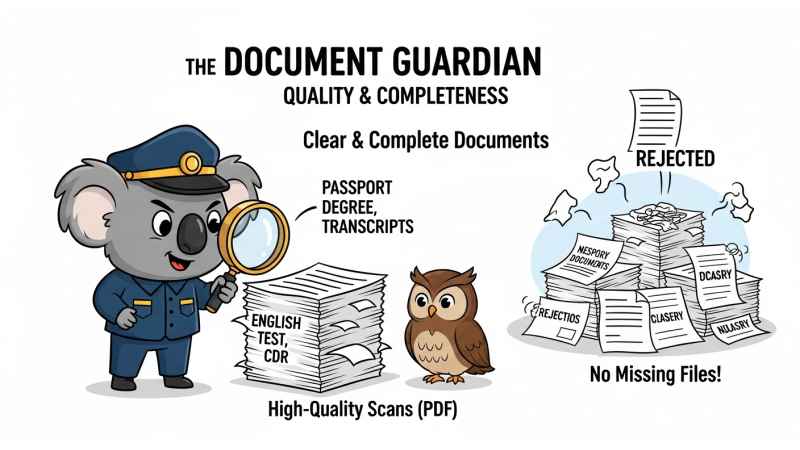
When applying for the OQA, you will need to submit several key documents through the EA online portal. Prepare clear, scanned PDF copies of each item:
-
Proof of Identity: A scanned color copy of the photo page of your valid passport or national ID.
-
Passport-Style Photo: A recent, clear photograph of yourself (JPEG or PNG).
-
Educational Certificates and Transcripts: Your degree certificate(s) and detailed academic transcripts (mark sheets) for each year of study. The transcripts should list courses and grades. If these are not in English, you must include certified translations.
-
English Test Results: Official score reports for IELTS, TOEFL, or PTE that meet EA’s minimum requirements.
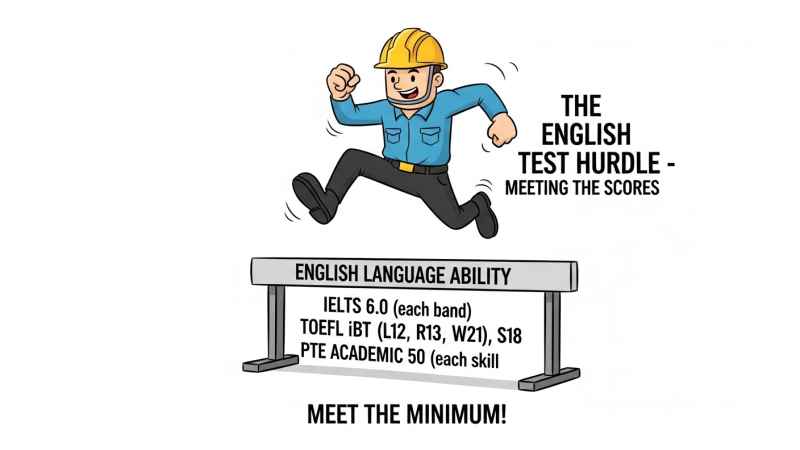
-
Curriculum Vitae (CV/Resume): An up-to-date CV outlining your education and engineering work experience.
-
CDR Report (if required): For CDR applicants, a complete Competency Demonstration Report (CPD list, 3 Career Episodes, and Summary Statement) prepared according to EA guidelines.
-
Reference Letters: Letters from employers or supervisors confirming your engineering work (if you have any relevant work experience) – optional but helpful, especially for CDR applicants.
-
Translations: As mentioned, any non-English documents must be translated into English by a certified translator.
Be very careful that each document is complete and legible. Missing transcripts or unclear scans are a common cause of delay or refusal. EA’s guidelines recommend scanning everything as PDF files and keeping file sizes reasonable. Double-check that your name is consistent on all paperwork (e.g. if you changed your name, include official name-change documents).
Tip: Before uploading, group your files clearly and label them (e.g. “Passport”, “Degree Certificate”, “IELTS Test Score”). This will help the assessor and keep your own application organized.
Step-by-Step Application Process
The OQA is done entirely online through the Engineers Australia portal. Here’s a breakdown of the process:
-
Choose Your Occupation: Identify your nominated skilled occupation from the ANZSCO list (e.g. Civil Engineer 233211, Mechanical Engineer 233512). The occupation you select should match your qualifications and career path.
-
Determine Your Pathway: Decide which assessment pathway applies (Washington/Sydney/Dublin Accord or CDR). Use EA’s Qualification Checker or accord signatory lists. If in doubt, the safe choice is to prepare a CDR, as it covers you if your degree isn’t accredited.
-
Register on EA Portal: Go to the Engineers Australia website (www.engineersaustralia.org.au) and create an account. Log in to the “Migration Skills Assessment” section. Choose “Migration Skills Assessment” after logging in.
-
Upload Your Documents: In the portal, create a new application and upload all required documents listed above. This will include identity, education, English test, CV, and CDR files as applicable. The portal guides you through each category. Make sure each upload is clear and complete.
-
Pay the Assessment Fee: Pay the EA skills assessment fee using a credit card. Fees depend on the pathway: for a standard Washington/Sydney/Dublin degree assessment it is currently about AUD 460 (506 incl. GST), whereas a CDR route costs around AUD 850 (935 incl.) (as of 2024). There may be additional fees if you add services (like including a skilled employment assessment or an overseas PhD assessment). Confirm the exact fee on EA’s official fee page before payment.
-
Await Assessment: After submission and payment, your application status will change to “Assessment in Progress.” At this point, EA will begin reviewing your documents. Standard processing typically takes 8–12 weeks. (EA also offers a fast-track option: for an extra fee, your application will be assigned to an assessor within 20 business days.)
It’s that simple! Once your application is in progress, you can log into the portal any time to check status updates. If EA finds missing information, they will request additional documents via the portal (your status may then become “Additional Information Requested”). In that case, respond quickly to keep the process moving.
What Happens After You Apply?
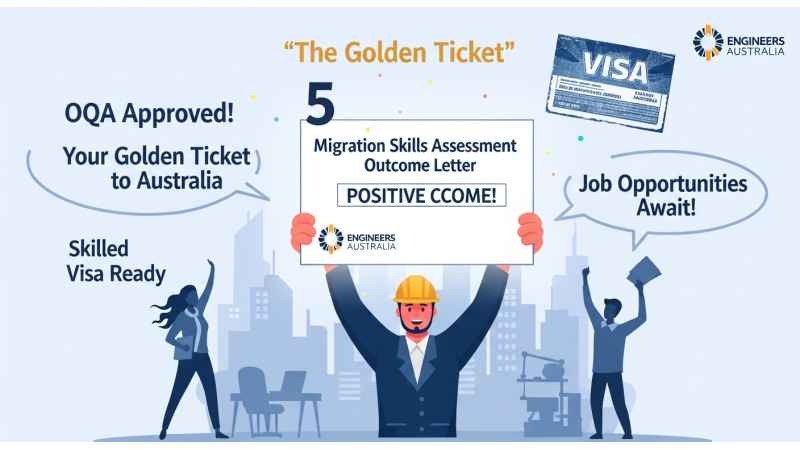
Once your OQA application is submitted and “in progress,” here’s what to expect:
-
Assessment: An EA assessor will thoroughly review your documents. They will check your degree validity (sometimes contacting the university), verify your test scores, and read your CDR if provided. This review can take several weeks.
-
Additional Information: If anything is unclear or missing, EA will change your status to “Additional Information Requested.” You’ll receive a message explaining what is needed (e.g. a missing transcript page or a clarification on a career episode). Provide the requested info promptly to avoid delays.
-
Assessment Complete: When the assessor has finished reviewing, your status will update to “Assessment Complete.” This means EA has made a decision.
-
Outcome Issued: Shortly after, EA will email you an official Migration Skills Assessment Outcome Letter. This letter states whether your assessment is positive or negative. It will include your name, EA applicant ID, the occupation you nominated, the outcome (positive/negative), the qualification EA recognized, and the date.
-
Positive Outcome: If your application is successful, the outcome letter confirms that your overseas qualification is recognized as equivalent to an Australian engineering qualification. You can then use this letter to apply for a skilled migration visa with the Department of Home Affairs. It’s also vital for applying to jobs – many employers require evidence of EA’s positive assessment.
-
Negative Outcome: If EA finds significant deficiencies, you will get a negative result. The letter will explain why (e.g. “insufficient equivalent education”). Don’t panic – you have options. You can request a review of the decision within 3 months, submitting further evidence or clarifications. Alternatively, you can reapply with better documentation or a new CDR if needed.
On receiving your outcome, remember that the result letter is yours to keep permanently with EA (it does not expire for EA purposes). Use it wisely as the official proof of your credentials.
Tips for a Successful Assessment
Preparing a thorough, well-organized application is key to a positive outcome. Here are some friendly tips:
-
Follow the Official Guidelines: Carefully read the Migration Skills Assessment Booklet and EA’s online instructions. This document lists exactly which forms and statements are required. Following it shows EA you are diligent.
-
Provide Clear, High-Quality Documents: Make sure all scans and photos are sharp. Illegible documents are a common reason for requests or rejection. For any non-English documents, use certified English translations to avoid confusion.
-
Prepare a Strong CDR: If you’re on the CDR pathway, write your Career Episodes with care. Include real technical details (mathematical calculations, engineering principles, design considerations) rather than vague descriptions. Custom-create your report for your story; EA has strict plagiarism checks. (Tip: Reflect on how each episode shows specific competencies, then highlight those in your Summary Statement.)
-
Double-Check Everything: Before hitting submit, review each form and file. Check names, dates, and numbers. Ensure your English score meets EA’s requirements. A quick checklist helps catch small errors.
-
Seek Professional Help if Unsure: If you are uncertain about any part of the process (especially writing a CDR), consider consulting an experienced migration skills assessment service. For example, a CDR specialist can review your draft, point out missing content, and help you avoid pitfalls. We at cdrforea.com have helped many engineers polish their CDRs and applications. Even a short consultation can save time in the long run.
By staying organized and following the rules, you dramatically improve your chances of a positive result.
Common Mistakes to Avoid
When preparing your Overseas Qualification Assessment, steer clear of these frequent errors:
-
Incomplete Documentation: Make sure no required file is missing. Commonly forgotten items include academic transcripts, English test results, or the passport photo page. An incomplete application can be quickly rejected.
-
Low English Score: EA must see a valid test score in your application. Don’t assume you can skip it. If your current score is below 6.0 in IELTS (or equivalent in TOEFL/PTE), consider retaking the exam beforehand.
-
Weak Technical Details: In your CDR Career Episodes, avoid being too general. Engineers Australia expects clear technical discussion – calculations, engineering methods, software used, outcomes of projects. Omitting these details or only describing duties can lead to a poor evaluation.
-
Misaligned Summary Statement: Your Summary Statement must clearly map your episodes to EA’s competency elements. Don’t just restate your episode paragraphs; explicitly tie each component of the skill standards to specific actions or paragraphs in your episodes. A disconnected or generic summary can cause refusal.
-
Ignoring EA’s Requests: If EA asks for more information (e.g. additional transcripts or clarification on a work reference), respond quickly. Failure to reply can lead to withdrawal of your assessment.
-
Plagiarism: Never copy content from sample CDRs or online sources. EA runs plagiarism checks and any duplicate text from another person’s CDR will result in immediate rejection. Always write original material.
Avoiding these mistakes will streamline your assessment and prevent delays.
Processing Time and Fast-Track Option
Under normal circumstances, Engineers Australia aims to process standard skills assessments in about 8 to 12 weeks from submission. However, this timeframe can vary depending on the complexity of your case and how busy assessors are. During busy seasons, it may take a bit longer.
If you’re in a rush (for example, if you have a tight visa deadline), EA offers a Fast Track service for an additional fee. With Fast Track, your application will be allocated to an assessor within 20 business days. This doesn’t guarantee an outcome in 20 days (the review itself can still take time), but it bypasses the initial queue. Keep in mind the Fast Track fee (around AUD 325) is on top of the normal assessment fee.
Always keep an eye on the EA portal to see when your status changes, and plan accordingly.
Using Your Assessment Outcome
A positive outcome from the Overseas Qualification Assessment is your golden ticket. It officially states that EA recognizes your degree as equivalent to an Australian qualification. With that, you can:
-
Apply for a Skilled Migration Visa: Your outcome letter is a key document when you submit an expression of interest or visa application in Australia. The Department of Home Affairs will ask for it as proof of your skills.
-
Seek Engineering Jobs: Many employers require EA recognition before they’ll hire an overseas engineer. You can confidently apply for positions knowing your qualifications have EA’s stamp of approval.
-
Apply for Memberships: If you wish to join professional bodies (like the National Engineering Register or Chartered status), the assessment result demonstrates you meet the educational criteria.
If your outcome is negative, review the reasons carefully. It might be something fixable (e.g. a missing page or insufficient detail in your CDR). You can either gather the missing info and request a reassessment, or appeal the decision. Sometimes re-applying with a revised CDR or clearer documents can lead to a different result.
Frequently Asked Questions
Q1: Do I have to do an Overseas Qualification Assessment?
Yes, if you studied engineering outside Australia and want your qualifications recognized for work or migration, you must pass the EA assessment. Only degrees from accredited Australian programs or full Accord signatories (with accreditation proofs) can sometimes skip the CDR, but everyone still needs an outcome letter.
Q2: I have no professional engineering experience yet. Can I still apply?
Absolutely. You can write your Career Episodes about engineering projects from your university studies, internships, or any technical work you’ve done (even during studies). EA understands new graduates won’t have years of work history. Just focus on what technical skills you used in those projects. Of course, any actual work experience you do have will strengthen your CDR, so include it if available.
Q3: Is IELTS the only accepted English test?
No – EA accepts IELTS, TOEFL iBT, or PTE Academic scores. Many applicants use IELTS, but if you have a recent TOEFL or PTE meeting the required scores, EA will accept it. Choose whichever test you’re more comfortable with. Ensure your scores meet the minimum bands listed above.
Q4: My assessment was refused. What are my options?
First, don’t panic. If EA issued a negative result, you have up to 3 months to request a review of the decision by providing new evidence. Alternatively, you can reapply fresh: fix any gaps (e.g. supply missing documents or rewrite your CDR for clarity) and submit a new application with a new fee. Many applicants improve on their first attempt.
Q5: How can cdrforea.com help me?
Services like ours specialize in Engineers Australia assessments. We can help you ensure your CDR and other documents are complete, well-written, and original. Our experienced writers offer personalized feedback on your Career Episodes and Summary Statement. If you’re unsure about any part of the application, professional guidance can boost your confidence and success rate. (Remember, only you should write your personal details and experiences – but an expert can guide the format and clarity.) If you’d like assistance, our team at cdrforea.com is ready to help with your CDR and application preparation.
Conclusion
For international engineers aiming to work in Australia, the Engineers Australia Overseas Qualification Assessment is a crucial first milestone. Passing it officially bridges your foreign degree to Australian standards, opening the door to skilled migration, exciting job opportunities, and further professional development. The process involves verifying your degree, demonstrating your English ability, and possibly submitting a detailed CDR.
The journey may seem complex, but with careful preparation it is entirely doable. Follow the steps: pick your pathway, gather and upload the correct documents, write a strong CDR if needed, and double-check everything. Use the official Engineers Australia Degree Assessment resources and the Engineers Australia Skills Assessment Guidelines for reference. Avoid common pitfalls like incomplete forms or low test scores. And remember, help is available – whether from friends who’ve done it, migration experts, or professional writing services.
By taking each step carefully and meeting Engineers Australia’s criteria, you can earn a positive assessment outcome. Stay persistent and best of luck on your path to becoming an engineer in Australia!
